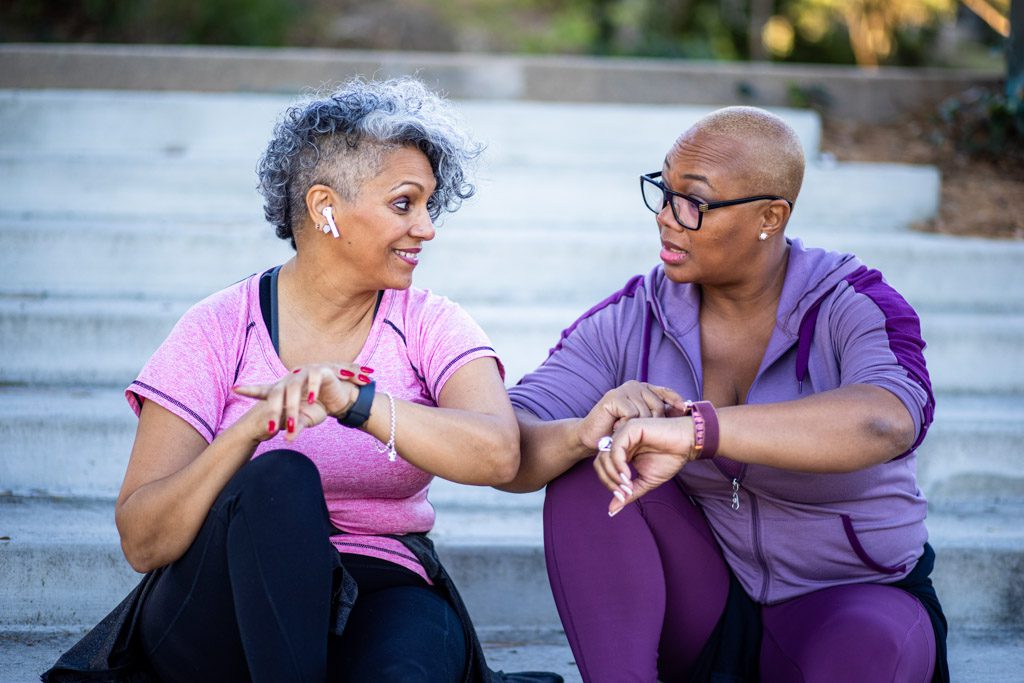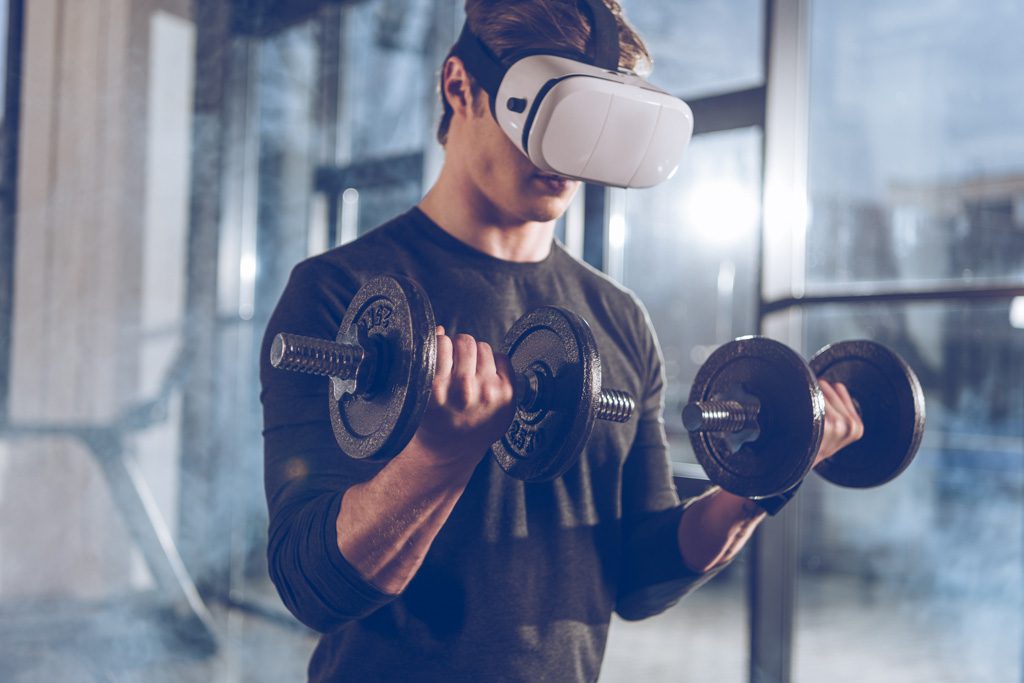Some fitness industry trends just don’t catch on—remember paddleboard yoga, Shake Weights and sauna suits?
Now you might only find these products at a garage sale, but their creators thought they were exactly what consumers wanted at the time. These fitness entrepreneurs watched their sales numbers dwindle while boot camps, CrossFit and functional fitness took off.
It’s never been easy to accurately predict which fitness trends will have a successful run or lasting impact. Now, with all the rapid technology developments in the post-pandemic fitness market, it’s even harder to predict which current fitness trends will catch on or how long their run will last.
Take Peloton, for example. The company exploded during the pandemic: In 2020 it had a market capitalization of almost $50 billion, with shares over $160. In April 2022, its market cap is $6.68 billion, and shares are at $20. (More on Peloton below!)
With new and interesting trends emerging all the time, it’s going to be fun to watch the evolution of the industry and play with all the new toys. To give you the lay of the land right now, we’ll dig into seven of the most popular fitness industry trends.
The Metaverse
We can’t go any further without mentioning the metaverse: Most fitness industry trends will hook into this new digital technology in some way. However, at this point Facebook founder Mark Zuckerberg is still constructing his version of the Metaverse, and most people outside the gaming community have a fuzzy definition of the concept.
To put it simply, the metaverse is the merging of virtual reality (VR) and the internet through web platforms capable of supporting the activities and creations therein. Users get the whole metaverse experience by donning a VR headset and gear before logging on to the web platform.
For example, imagine entering a web space where your avatar can interact with the avatar of your instructor in the exercise environment you choose. You might find yourself throwing punches in a boxing ring, rowing on a lake, running through a forest or meditating in a meadow.
This experience is already possible through VR fitness companies such as Within, the developer of the workout app “Supernatural.” Recently, Zuckerberg’s Meta acquired Within. So, “Supernatural” will have a metaverse address.
The Metaverse will also allow fitness VR companies to create more exercise environments and interactions with AI or the avatars of other real people. Expect exciting updates as new fitness products are created for the metaverse.
Now, on to our list of fitness industry trends.

1. Top Fitness Industry Trend: Wearables
With global revenues close to $90 billion, the wearable devices market is robust, with no signs of the gear ending up in a garage sale anytime soon. Instead, it is a fitness market niche where Fitbit, Apple and Garmin make most of the money. However, new entrants and wearable products are making inroads and carving out market share.
Wearable activity trackers and related app technology provide solutions to for many fitness consumers. Modern exercisers want:
- To effortlessly track our activities and performance.
- To qualitatively monitor our activities.
- Information on overall wellness.
- Instant feedback.
Smart watches and fitness trackers now record and display our stress levels, body temperature, heart rate and sleep patterns in addition to other metrics. And they’re only getting better. For example, human performance company WHOOP is marketing a wearable that tracks your strain, recovery, sleep and overall health.
However, activity trackers aren’t the only innovative products in the wearable fitness gear market. For example, sports apparel companies such as Under Armour are marketing smart shoes that communicate with a mobile app to monitor and report running data. Some clothing manufacturers even claim their gear will help you improve yoga poses and running performance, and there’s even swimwear that monitors UV exposure.
Also, for those who don’t want to advertise their fitness tracking, brands like Oura and Bellabeat offer fitness tracking products that appear as classic pieces of jewelry.
When it comes to wearable tech, we’re just getting started. Of all fitness industry trends, this one looks like it will influence consumers for years even if the exact technology evolves.
2. Seamless Integration Between the Virtual and In-Person Fitness Environments
As a survival tactic during the pandemic, many coaches moved their businesses online, offering home-bound clients personal training sessions; exercise classes; nutritional advice; and coaching on sleep, motivation and stress management. Many of us didn’t realize that period was the beginning of a new era in fitness.
Even though pandemic restrictions have been lifted for the most part, the virtual fitness world is still operating at full speed after two years of experimentation and evolution. The eCommerce environment is now rich with fitness products and services, and coaches have more tools at their disposal, whether they operate online or use the new tech to provide more to their clients outside the gym.
The pandemic forced great coaches to expand their reach outside the physical space, and many learned they can do even more for clients with a holistic approach. This helps clients make progress faster, but it also reduces cost of revenue (COR) in some cases and extends market reach for many coaches.
Here are just some of the changes:
- Coaches have access to new channels and apps for client engagement and metric tracking/analysis.
- Clients are more receptive to online coaching, instant messaging, digital accountability, and app-based communication and communities.
- Clients see the value in vacation, travel or at-home workouts that are integrated into a plan that includes training at a physical location. (See Hybrid Memberships, below.)
- Fitness trainers can offer more habits-based coaching on outside-the-gym activities such as sleep, stress management and nutrition.
- Clients have improved access to at-home fitness products to supplement training in a gym.

3. Hybrid Memberships
The powerful integration of in-person and virtual fitness has highlighted the benefits of “hybrid memberships”—one of the hottest fitness industry trends of 2022.
Due to the increased fitness consumer demand for convenient online options, some gym owners are offering a newer version of conventional memberships that give members access to in-person coaching and on-demand online services.
For example, a coach might offer personal training once a week, plus four at-home workouts and habits-based nutrition and recovery coaching. An increasing number of fitness clients experienced this sort of coaching during the pandemic, so more people now realize the effectiveness and value of these hybrid memberships. A high-touch package like the one described above might sell for $300 a month or more.
Coaching: Inside or Outside the Gym
In 2019, many fitness aficionados might have named access to a gym and its equipment as the main benefit of membership. Over the course of the pandemic, many people realized that coaching is incredibly valuable and can take place in person or online. Moreover, many exercisers found at-home workouts saved time and allowed them to train more often. Instead of a 15-minute trip to the gym for a 60-minute workout, clients could simply run to the garage to perform a short session programmed by a personal coach who reviewed video to offer tips.
After the pandemic lockdowns ended, some coaches stayed online for good, but others returned to the gym and linked bricks-and-mortar facilities to online services. The result: a best-of-both-worlds situation in which consumers have more options than ever. In the past, gym owners might have lost clients who wanted to use a digital system for at-home workouts. Now, they can integrate those systems into complete wellness plans.
If you don’t have a virtual extension to your gym, you can scale your gym business with a hybrid relationship that involves virtual fitness providers. For example, Sona Online hosts a wide variety of live streaming and recorded fitness classes, including HIIT, core, cardio, etc. It’s also launchable on the Apple Watch app. A coach could prescribe Sona workouts to complement other aspects of a personalized plan.
Beyond coaching gyms, other commercial facilities are taking advantage of this fitness trend. Here are two examples:
- Odyssey by VIDA Fitness: Odyssey provides live, high-energy online fitness classes from six locations in Washington, D.C., and Virginia. Memberships allow people access to facilities and outdoor and virtual classes.
- Wheelhouse On Demand: Wheelhouse has a hybrid fitness studio with a prominent online following. Train in person or access live-streamed or prerecorded classes.
Aside from providing a virtual option for clients, hybrid memberships allow owners to diversify their sources of income, affordably scale or get ahead of the competition.

4. AI Coaching and Personal Training
Technological advances in artificial intelligence (AI) and machine learning (ML) produce products that can replace pizza cooks, Uber drivers, camera persons, janitors and even lab techs. AI fitness might provide real-time personal instruction, but it lacks the intuitive and intangible abilities needed to completely replace human coaches who build strong personal relationships with clients. Nevertheless, AI and ML devices serve as excellent training aids.
How do AI Coaches and Personal Trainers Work?
AI coaching works by tracking your movements during exercise and health-related activities to help you make the necessary changes to reach your goals. To achieve this function, you would use your smartphone or smartwatch equipped with AI and ML to analyze data collected from sensors in your fitness wearables.
Depending on the app, the sensors collect personal data that includes your movements and body position, calories burned, heart rate, repetitions count, and other metrics. Then, your device uses ML and AI to give you real-time analysis and instruction to improve your performance and get better results. Also, along with using your data, AI coaches use a digital library of expert knowledge to offer you better workout and lifestyle strategies consistent with your anatomy, fitness level, goals and feedback.
The AI Influence
AI and the “internet of things” (IoT) have made the fitness industry a hotbed of innovation, with new fitness products entering the market regularly. By the year 2027, industry experts predict the fitness app market will be worth $14.64 billion, with over 100 million fitness consumers in 2024.
5. In-home Fitness Equipment
As many people headed back to gyms in 2021, the fortunes of the in-home fitness industry took a drop from 2020 pandemic highs. However, all indications show that at-home training is still among the top fitness industry trends, with Fortune Business Insights projecting a compound average growth rate (CAGR) of 4.6 percent from 2021 to 2028.
This projected growth is partly due to new users who turned to at-home products during COVID lockdowns. In addition, many consumers emerged from the pandemic era with a keen desire to maintain their health without travel time, and the new work-from-home trend has disrupted commuting patterns. Some consumers also have more disposable income to spend in fitness products because of sharp changes in spending habits over the course of the pandemic.
Here are a few examples of popular at-home fitness products:
The Mirror
Like the other product-related trends, digital technology is revolutionizing at-home fitness equipment with features once associated with science fiction, fantasy and horror movies. Imagine an image in your mirror that talks to you—and tells you to squat deeper.
In today’s digital environment, this scenario is no longer farfetched because of companies such as Mirror. This New York-based startup recently launched a unique product that allows people to get the live, interactive exercise-class experience at home. The system features a 52-inch rectangular mirror that transforms into an interactive exercise venue where you can hear and see the instructor and your classmates.
From the comfort of your home, you can stream more than 50 live fitness classes every week from Mirror’s New York studio. Some of the top fitness instructors lead the classes. You can also select on-demand workouts from a vast library that includes boxing, cardio, yoga, strength, HIIT and many other disciplines.

Peloton
Peloton gained fame as the flagship product in the COVID 19 at-home fitness revolution. The company offers streaming video feeds of live exercise classes on its exercise bikes and treadmills. For several years, it has been a leader in cardiovascular training equipment—and stationary cycles have a 41.4 percent share in the global at-home exercise equipment market. However, Peloton’s dominance has begun to wane.
In January 2022, Peloton’s shares sank 24 percent from news of the temporary halt on its bike production on top of its hiring freeze in November 2021. Early in 2022, the company’s sales and marketing staff was bracing for possible layoffs of 41 percent of workers. In February 2022, the company laid off 2,800 workers.
Apparently, Peloton has become a victim of its own success. Along with attracting more competitors into the field, a 172 percent sales spike in 2020 gave a false impression of future demand. As a result, the initial tidal wave of demand in 2020 overwhelmed Peloton’s product supply.
As a response, the company bought the exercise equipment manufacturer Precor. Then it ramped up its supply of bikes and treadmill products to the point of being seriously overstocked in the face of a demand level far below its forecasts. According to expert Brian O’Rourke, Peloton’s projected $8 billion valuations depended on a 60 percent home-fitness market share—an unreasonable number.
Problems aside, Peloton is making moves to recover and is still a player in the game. In spring 2022, the company announced reductions in equipment price and increases in subscription price. Only time will tell if these moves will pay off.
Gamified Workouts
A significant development during the pandemic lockdown was the increased popularity of gamified workouts. One of the most popular apps for at-home exercise use is Zwift. This mobile app allows you to use your existing bike for racing your friends or others online in a multiplayer video game format. Also, you can use Zwift on a treadmill.
But you can go further into the video-game-meets-workout world with VR products such as Beat Saber, Pistol Whip, Dance Central and so on. It’s not clear how effective some of these games will be when it comes to improving fitness, but they get people off the couch and make movement fun. Expect more in the future.

6. Publicly Traded Fitness Boutique Franchises
Move over CrossFit. A few publicly traded franchises have started a whole new wave of exciting growth in group fitness. Two of the hottest fitness franchises are F45 and XPOF.
F45
Rising star F45 is a provider of group classes that rocked the industry by becoming the first publicly traded boutique fitness studio. In addition, business for F45 has been terrific on a global scale, with over 1,900 franchises in more than 50 countries.
The “F” in F45 stands for fundamental. This little detail shows F45’s similarity to CrossFit. However, though the principles of both systems are similar, F45 differs from CrossFit in some key areas. Some differences are:
- F45 workouts are the same around the world, whereas all CrossFit affiliates program their own workouts.
- The atmosphere is less competitive than in CrossFit.
- The F45 program uses more technology as a workout enhancer.
- F45 focuses more on cardiovascular health than strength training.
- F45 workouts are just 45 minutes.
Online reviews indicate that F45 is more popular than CrossFit with some demographics because it is less competitive. Nevertheless, the fitness franchisor has a long way to go before reaching the success of CrossFit. But the F45 program is highly appealing, and its scalable franchise model makes F45 a real force in the fitness market.
XPOF Fitness
With over 2,100 franchises, Xponential Fitness is a significant international franchisor of boutique fitness brands. Its objective is to grant access to 10 boutique brands.
At present, Xponential Fitness offers a diversified platform including running, dancing, functional training, boxing, yoga, stretching, barre and cycling. It has a presence of 2,100 studios in 48 states and 12 counties. Among the brands are:
- Club Pilates—the largest Pilates brand.
- CycleBar—the largest indoor cycling brand.
- StretchLab—one-on-one and group sessions.
- Row House—low-impact, high-voltage indoor rowing.
- AKT—dance-based cardio.
- STRIDE—cardio and strength training involving the treadmill.
As boutique fitness goes mainstream, Xponential Fitness is a player to watch.

7. Flexercise
Not long ago, most people relegated stretching to warm-up and cool-down periods. Or they might have taken a yoga class now and then. However, flexibility and functional strength training are trending upward.
Flexercise is a holistic approach to fitness that promotes various forms of working your mind and body, including stretching, low-impact workouts, Pilates, walks, yoga moves and several other movement forms. It can also include lighter or shorter versions of some existing exercises or programs.
People can perform flexercise in the gym, outdoors or at home, and anyone can join in at any time. To the consumer, flexercise is accessible and convenient.
What Do These Fitness Industry Trends Mean for the Future?
The fitness industry had a market value of around $81 billion in 2020, with a compound average growth rate of 7.2 percent projected from 2021 to 2026. As tragic and dreadful as the COVID-19 pandemic was, it served as a turning point that accelerated the end of some dated and waning fitness business models and the emergence of new business trends.
The fitness industry trends described above are just some of the exciting developments that will help coaches and businesses get more people moving. More great things are coming.
Two-Brain Business specializes in helping gym owners create solid, stable businesses that evolve, adapt to current fitness industry trends and help clients get results. For info about working with a mentor to grow your fitness business, click here to book a free call.
About the Author: John Burson successfully ran a personal training business for over 20 years, and he has written volumes of published articles on business entrepreneurship, finance and the fitness industry.

